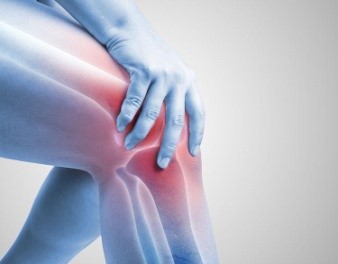Knee pain is a common ailment with many different causes. Sometimes it’s the result of an injury or trauma, but other times, sudden knee pain seems to come out of nowhere and could signal a larger health problem like arthritis.
“There are so many things that can go wrong in your knee,” says Alice Holland, a doctor of physical therapy at Stride Strong Physical Therapy in Portland, Oregon, USA.
Most unexplained knee pain comes on gradually, she says, usually a sign of the beginnings of joint inflammation and arthritis. Another important consideration is the location and severity of the pain at your knee.
For example, pain below your kneecap might be a sign of patellar tendinitis, or inflammation in the tendon that connects the kneecap to the shinbone, says Cleveland Clinic rheumatologist Scott Burg, DO, who also asks patients to describe their knee pain.
“I know, it’s a tough question sometimes,” Burg says. “But you probably can tell the difference between a dull, throbbing pain and a sharp, burning sensation.”
If you’re reading to get to the bottom of that pesky knee pain once in for all, know that your doctor may find that one of these six conditions could be the cause of your sudden knee pain.
Causes of sudden knee pain
Osteoarthritis: Sudden knee pain could be the onset of osteoarthritis, a degenerative joint disorder and the most common type of arthritis. Osteoarthritis develops as people age and the cartilage that cushions the ends of your bones wears down, allowing the bones to rub against each other, according to the Arthritis Foundation.
“In terms of knee pain that comes out of nowhere, that’s the beginnings of joints rubbing together and causing inflammation,” Holland says. “Inflammation is your body’s natural way of padding a damaged area.”
Osteoarthritis is caused by many factors, including injury, overuse and inactivity.
Psoriatic arthritis: Arthritis exists in many forms, and some types, like psoriatic arthritis, are autoimmune conditions, Yagnik says. Psoriatic arthritis affects the skin and joints, especially in the knee.
The condition triggers the body’s immune system to mistakenly attack healthy tissues, leading to inflammation, pain and joint damage. According to Cleveland Clinic, psoriatic arthritis in the knee causes pain, tenderness, swelling, stiffness or decreased range of motion, and silver or gray scaly patches or itchy, red spots to appear on the skin.
Researchers aren’t sure what causes psoriatic arthritis, but genetics and environmental factors are likely to blame. People with psoriasis, immune system issues, infection, obesity and trauma to the joint are especially at risk.
Infectious arthritis: Infectious arthritis, also called septic arthritis, comes on suddenly and can permanently damage joints, according to the Arthritis Foundation. It usually attacks a single joint, commonly the knee.
Bacteria, like staph, cause most cases, infecting a joint or the fluid around a joint. But some cases can be viral or fungal. The infection may be contracted after surgery or through an open wound. Swelling, pain, fever and chills are signs of infectious arthritis.
Gout: Gout, an inflammatory type of arthritis, causes sudden pain in the joints, and usually affects one joint at a time, according to Cleveland Clinic. It also causes swelling, tenderness and warmth around the joint. Men are more likely to get gout, but it can affect women, especially after menopause.
Often originating in the big toe, gout can affect other joints in the leg, like the knee, ankle or foot. Gout attacks may hit rarely, like once a year, or more frequently.
Gout is caused by extreme amounts of uric acid in the body that enables excessive amounts of uric acid crystals to form in the joints and soft tissue, creating a lump, called a tophus. Uric acid levels fluctuate because of kidney function, diet, alcohol consumption, medication, weight and how much water you drink.
Rheumatoid Arthritis: Rheumatoid arthritis is an autoimmune inflammatory condition, likely caused by genetics, Yagnik says. What’s different about rheumatoid arthritis is that it usually affects joints on both sides of the body, such as both knees, according to Cleveland Clinic.
In rheumatoid arthritis, the immune system releases inflammatory chemicals that attack the synovium, or tissue that surrounds joints and produces fluid to keep the joint moving well. Inflamed synovium gets thicker and makes movement difficult and painful.
Some cases of rheumatoid arthritis develop slowly over time, but others can occur quickly. Symptoms include joint pain, swelling and stiffness, especially in the mornings or after sitting for too long.
Runner’s Knee: Chondromalacia patella, better known as runner’s knee, refers to the deteriorating cartilage on the underside of the kneecap caused when the kneecap rubs against the thigh bone, according to the Arthritis Foundation.
Runner’s knee is most common in young adults, women and athletes, who participate in high-impact sports. It’s caused by overusing the joints and could lead to osteoarthritis in the knee. But, that doesn’t mean you should avoid running or other workouts, Yagnik says.
“There’s not one specific thing that I would say, ‘Hey, you need to avoid these exercises or don’t participate in these activities because you’re going to get arthritis,’’ he says. “Now, for someone who starts to develop a little bit of early arthritis, either through genetics or an injury, we advise activity modification or smarter training.”
Runner’s knee pain often gets worse after sitting for long periods, going up and down stairs, kneeling or squatting. Treatments include over-the-counter medications like ibuprofen, knee supports like braces or wraps, physical therapy or surgery.
To keep the knee healthy, ease pain and prevent osteoarthritis, ice the knee several times a day, perform stretching and strengthening exercises, maintain a healthy weight, rest your joints and tape the knee to keep the kneecap in alignment.
Get knee pain looked at early
If you have unexplained knee pain, visit your doctor or physical therapist as soon as you can. This will keep the pain from getting worse and help you avoid costly treatments like surgery with longer recovery periods.
This article first appeared on Yahoo News


